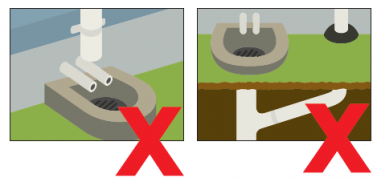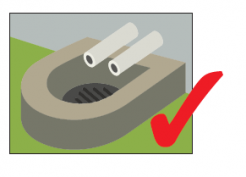Looking after your wastewater – cross connections
Unfortunately, a common mistake with residential plumbing and drainage works is connecting wastewater (sewer) pipes into stormwater pipes or stormwater pipes into the wastewater system. This is known as cross connecting and it can result in serious adverse effects on public health and the environment. A common source of cross connections is a downpipe diverted into the gully trap (a drainage vent usually covered with a small grating and located against the outside of a house, near the kitchen, laundry, or bathroom).
The two networks are separate, and it is the property owner’s responsibility to ensure they stay that way. Make sure you and your tradesperson connect the right pipes to the right network.
Why is a cross connection bad?
Stormwater in the wastewater network increases the volume at the wastewater treatment plant by up to five times dry-weather levels. It can overload the plant, leading to a discharge of only partially treated water and it can overload the network and cause wastewater to flow out of manholes.
Wastewater connections to stormwater pipes have an equally harmful impact. Due to a faulty connection or leaks, wastewater can overflow and end up in the stormwater system, which transports directly into our streams, rivers, and the sea.
Whose responsibility is it to fix a cross connection?
It is your responsibility to make sure your drainage pipes connect to the right system. If you are getting drainage work done for an extension or new development, ensure your drainlayer is 100% confident your pipes are going where they should.
The pipe from the roof should connect to the stormwater system, not the sewer/wastewater system. If the downpipes from your roof connect into the gully trap, then you will need to redirect it into the stormwater system.

These pipes have been connected incorrectly - Left: The downpipe flows into the gully trap and wastewater network. Right: The stormwater lateral pipe is connected to the wastewater pipe.
The lateral pipe connects to your gully trap and direct toilet connections, taking wastewater out of your property to the public wastewater network. This pipe is your responsibility. This pipe is buried underground and is hard to see. You will usually only realise there is a problem with your lateral pipe when it either leaks up onto the ground or blocks and comes out of your gully trap. If this happens, please contact a plumber.
The lateral pipe can become damaged over time from tree roots growing beside or into it, land movement, or if it is accidentally damaged during construction or building works. Take some time to know where your lateral pipe is and avoid planting trees too close or damaging it with gardening work or retaining walls.
A gully trap is a plumbing feature that should only receive wastewater from your kitchen, bathroom and laundry. It connects to the wastewater network which carries the wastewater to a treatment plant. The top of the gully trap needs to be above ground level to prevent stormwater getting in and it should be partially covered to stop objects getting into the wastewater network but allow flow out onto the ground (and not inside your house) if your wastewater pipe does gets blocked.
Correct connection: The gully trap should only receive wastewater.
